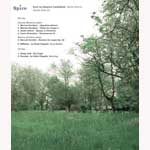|
|
 |
Dusted Reviews
Artist: V/A Album: Spire: Live in Geneva Cathedral Saint Pierre Label: Touch Review date: Jul. 10, 2005 |

|
|
|
 |
Geneva’s St. Pierre Cathedral (St. Peter’s, usually, to English speakers) has been host to its share of monumental history. The church, built in 1160, was the site of John Calvin’s revolutionary teachings and a central location in the Reformation movement. On September 4, 2004, however, the cathedral played home to a different sort of event, one in which the church’s role in religious history was only a secondary attraction. In conjunction with Touch’s Spire: Organ Works Past, Present, and Future, a night of performances had been planned; rather than marvel at a chair once occupied by Calvin in thought, attention centered on the cathedral’s organ and the architecture of the building in relation to the music performed there. The night consisted of three distinct phases: the structural, deconstruction, and reconstruction. Through the three stages, the music of what Thierry Charollias calls “the king of instruments” was performed, examined, and redefined through the work of not only contemporary organ players and composers, but also a trio of artists whose relationship to the organ is more tangential. This two-disc set is a document of the night’s music, and while I’m rather certain it doesn’t compare to being in the cathedral that night, Spire: Live in Geneva Cathedral Saint Pierre remains an engrossing treatise on the relevance of an instrument too often forgotten by modern secular music.
The album’s structural phase features modern organ compositions performed by Charles Matthews and Marcus Davidson. Interestingly, Matthews chose to play two pieces by Davidson, as well as works by André Jolivet and Liana Alexandra. Davidson’s contribution is Henryk Gorécki’s 16-minute “Kantata fr Organ Op. 26.” The selections performed in this phase exhibited the organ’s austere beauty, as well as its potential in the realms of more modern composition. Alexandra’s “Conconances III” is a highlight that utilizes wonderfully some of the organ’s potential for bombastic, yet minimalist, beauty. Gorécki’s piece is another of the disc’s best, beginning with thick drones before detouring into much quieter low-end rumble. The clout of the piece is a perfect end to this phase of the event, a final reminder of the pure power of the instrument before the deconstruction began.
The night’s deconstruction took place in smaller venues, a small chapel adjacent to the cathedral, and the crypt area underneath. BJ Nilsen’s half-hour “Rues Basses” began the second movement of the performance, with the performer alternating between electronics in organ, creating a sprawling sea of thunderous sound. Deep organ ebbs and flows over a crackling stream, as the instrument’s distinctive voice slowly fades into the insistent buzz. Single tones ring out, buffered by silence, before Nilsen invokes the organ to end the piece in a short-lived revival. Later, in the crypt, turntablist Philip Jeck continued the deconstruction. He begins with layered samples of organ before introducing other instruments into the piece, most notably some heavy, jarring guitar riffs and a repetitive, mechanical loop that evokes thoughts of robotic movement. While Nilsen’s deconstruction was of a more subtle nature, Jeck appears determined to deform the original sound of the organ through conspicuous stylistic battery, an approach that not only upsets the homogeny Spire had heretofore attained, but also puts Jeck, and his manipulations in the spotlight, rather than the organ itself.
The whole of the album’s reconstruction phase is Christian Fennesz’s 25-minute offering, which was performed in the morning in the chapel. Fennesz slowly lowers a shimmering blanket of sound on the listener, combining organ tones and electronics into an ethereal chorus. As paths converge and diverge, layers of sound are uncovered, and though Fennesz works in a rather minimalist mode, his piece is perhaps the album’s richest, and a fittingly sublime conclusion to the album and concert.
By Adam Strohm
|







